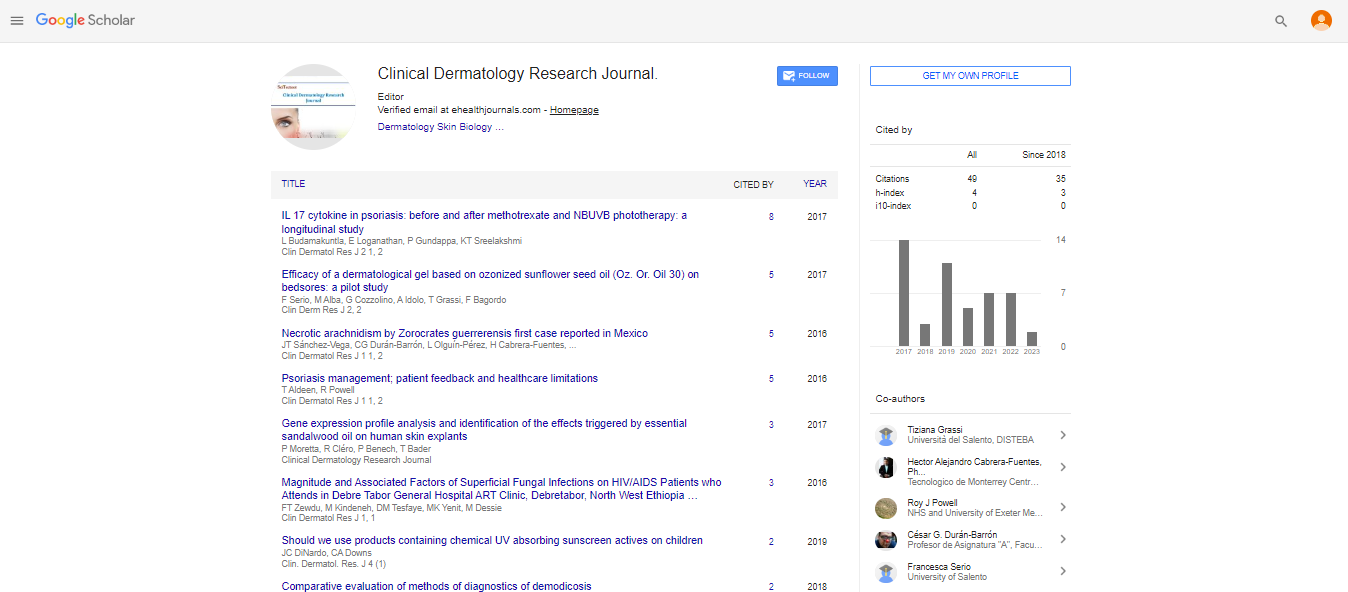Perspective, Clin Dermatol Res J Vol: 8 Issue: 4
A Comprehensive Overview of Procedural Dermatology Techniques, Advancements, and Clinical Applications
Ryan Chen*
1Department of Dermatology, University of Pennsylvania, Pennsylvania, United States of America
*Corresponding Author: Ryan Chen,
Department of Dermatology, University
of Pennsylvania, Pennsylvania, United States of America
E-mail: chenr29@gmail.com
Received date: 20 November, 2023, Manuscript No. CDRJ-23-127649;
Editor assigned date: 22 November, 2023, PreQC No. CDRJ-23-127649 (PQ);
Reviewed date: 07 December, 2023, QC No. CDRJ-23-127649;
Revised date: 15 December, 2023, Manuscript No. CDRJ-23-127649 (R);
Published date: 22 December, 2023, DOI: 10.4172/2576-1439.1000216
Citation: Chen R (2023) A Comprehensive Overview of Procedural Dermatology Techniques, Advancements, and Clinical Applications. Clin Dermatol Res J 8:4.
Description
Procedural dermatology stands at the intersection of medical science and artistry, offering a diverse array of techniques to diagnose, treats, and manage various dermatologic conditions. From laser therapies to surgical excisions, this specialized field encompasses a wide range of procedures aimed at enhancing both the health and aesthetics of the skin. In this comprehensive exploration, we delve into the intricacies of procedural dermatology, examining its techniques, advancements, and clinical applications.
Procedural dermatology
Procedural dermatology encompasses a broad spectrum of interventions aimed at addressing skin conditions, ranging from benign lesions to malignant tumors. Dermatologists utilize various techniques to diagnose and treat these conditions, including but not limited to:
Biopsy: A fundamental diagnostic tool in dermatology, biopsy involves the removal of a small sample of skin tissue for examination under a microscope. Different biopsy techniques, such as punch biopsy and shave biopsy, are employed based on the nature and location of the lesion.
Cryotherapy: Cryotherapy utilizes extreme cold to destroy abnormal or diseased tissue, such as warts, actinic keratoses, and certain skin cancers. Liquid nitrogen is commonly used in this procedure to freeze and subsequently remove targeted lesions.
Electrosurgery: Also known as electrodessication and curettage, this technique involves the use of an electric current to destroy tissue, followed by scraping (curettage) of the affected area. Electrosurgery is often employed for the removal of benign skin growths and certain non-melanoma skin cancers.
Laser therapy: Laser technologies have revolutionized the field of dermatology, offering precise and targeted treatment options for various skin conditions. Different types of lasers, including ablative and non-ablative lasers, are used to address concerns such as acne scars, vascular lesions, pigmented lesions, and unwanted hair.
Mohs micrographic surgery: Mohs surgery is a highly specialized technique for the removal of certain skin cancers, particularly those with aggressive or ill-defined borders. It involves the systematic removal and examination of thin layers of tissue, allowing for precise tumor removal while minimizing damage to surrounding healthy tissue.
Advancements in procedural dermatology
In recent years, significant advancements have been made in procedural dermatology, driven by innovations in technology, techniques, and understanding of skin biology. Some notable advancement includes:
Targeted therapies: The advent of targeted therapies, such as immunotherapy and molecularly targeted agents, has revolutionized the treatment of advanced skin cancers. These therapies specifically target molecular pathways involved in tumor growth and immune evasion, leading to improved outcomes and reduced side effects compared to traditional chemotherapy.
Minimally invasive procedures: There is a growing trend towards minimally invasive procedures in dermatology, driven by patient demand for less downtime and fewer complications. Techniques such as fractional laser resurfacing, microneedling, and injectable fillers offer effective solutions for skin rejuvenation, scar revision, and facial contouring with minimal risk and downtime.
Artificial Intelligence (AI) in dermatology: AI-driven technologies hold promise in improving diagnostic accuracy and treatment planning in dermatology. Machine learning algorithms trained on large datasets of dermatologic images can aid in the early detection of skin cancer, identification of rare dermatologic conditions, and personalized treatment recommendations based on individual patient characteristics.
Robotic surgery: Robotic-assisted surgery is emerging as a valuable tool in procedural dermatology, particularly in the field of Mohs micrographic surgery. Robotic platforms offer enhanced precision and dexterity, enabling surgeons to perform complex procedures with greater accuracy and efficiency.
Clinical applications and considerations
Procedural dermatology plays a vital role in the management of various dermatologic conditions across diverse patient populations. From routine skin exams to the treatment of complex skin diseases, dermatologists employ procedural techniques to address a wide range of clinical scenarios. Key clinical applications include:
Skin cancer management: Procedural dermatology plays a precarious role in the diagnosis and treatment of skin cancer, including basal cell carcinoma, squamous cell carcinoma, and melanoma. Techniques such as excisional surgery, Mohs surgery, and topical therapies are employed based on the type, size, and location of the tumor.
Cosmetic dermatology: The field of cosmetic dermatology utilizes procedural techniques to enhance the appearance of the skin, address signs of aging, and improve overall aesthetic outcomes. Procedures such as botulinum toxin injections, dermal fillers, chemical peels, and laser treatments are commonly performed to achieve desired cosmetic results.
Cosmetic dermatology: The field of cosmetic dermatology utilizes procedural techniques to enhance the appearance of the skin, address signs of aging, and improve overall aesthetic outcomes. Procedures such as botulinum toxin injections, dermal fillers, chemical peels, and laser treatments are commonly performed to achieve desired cosmetic results.
Scar revision: Procedural dermatology offers various options for scar revision, including surgical excision, laser therapy, and injectable fillers. These techniques aim to improve the appearance and texture of scars resulting from trauma, surgery, or skin conditions such as acne.
Treatment of dermatologic conditions: Procedural dermatology encompasses the treatment of various dermatologic conditions beyond skin cancer and cosmetic concerns. Procedures such as cryotherapy, electrosurgery, and laser therapy are utilized in the management of conditions such as warts, acne, psoriasis, and vascular lesions.
 Spanish
Spanish  Chinese
Chinese  Russian
Russian  German
German  French
French  Japanese
Japanese  Portuguese
Portuguese  Hindi
Hindi 

